Long Beach Aquarium’s tiger shark is a picky eater

- Share via
Tiger shark. A voracious predator known for traveling the world’s oceans and consuming everything in its way: smaller sharks, boat cushions, license plates, copper wire, shipwrecked sailors.
But on a recent Tuesday, the new 5-foot-long tiger shark at the Aquarium of the Pacific in Long Beach refused to even acknowledge a chunk of restaurant-grade ahi tuna dangled in front of its broad snout.
That worried Assistant Curator Steve Blair, whose duties include trying to keep one of the few tigers sharks in captivity in the United States as comfortable, healthy and stress-free as possible. After all, one of the first questions people ask when they enter the facility is, “Where are the sharks?”
Leaning over the creature’s outdoor tank with the tuna offered in a pair of 3-foot-long tongs, Blair was losing patience.
“Come and get it,” he urged. But the dark gray shark cruised past with a swish of its long curved tail. “You’re really going to like this. In a restaurant it’s a $20 dinner.”
No dice. “OK. Let’s try something else,” he said, replacing the tuna with a large piece of mahi-mahi.
Nope. “How about halibut?” he said.
“So, you’re not into halibut either,” he said. “Shrimp?”
After 15 minutes, Blair called it quits. “I’ll be back,” he told the shark.
In the aquarium’s stainless steel kitchen, where staffers spend mornings prepping meals for more than 10,000 marine creatures large and small, Blair compared his relationship with the tiger shark to “a dance routine.”
“Some days she won’t eat,” he said. “Other days she goes on benders, feasting only on one type of food. Her tastes change from one day to the next. The tricky part is figuring out what thing triggers her hunger on a given day.”
None of the aquarium’s creatures are as picky. Jellyfish eat brine shrimp four times a day. Rays gobble up squid. A 10-foot-long sawfish goes for mullet. Bamboo and zebra sharks are so fond of clams and shrimp that their caretakers are always on alert for signs of obesity.
The tiger shark is scheduled to eat about half a pound of meat a day. But its menu has expanded to include more than 30 potential offerings, including mackerel, snapper, squid, ono, fresh water eels, chicken, flank steak, quail and $20-a-pound lobster tail.
“Name it,” Blair said, “and we’ve probably tried it.”
So much for the popular notion that Galeocerdo cuvier is a perpetually hungry “wastebasket of the sea.”
The aquarium’s tiger shark came from Taiwan, where its mother had been caught in a fisherman’s net. The captured tiger shark gave birth to several pups, which were bought by an animal supplier who contacted the aquarium.
“We chewed on the offer for a couple of months,” recalled Perry Hampton, the aquarium’s director of animal husbandry. “Tiger sharks are a very challenging species to maintain. There is not a whole lot of information to go on.”
“But because it was young and small, we felt we had a reasonable chance of success,” he said. “If nothing else, we could push back the boundaries of knowledge about caring for this species in aquariums.”
In their natural haunts, tiger sharks can grow up to 14 feet long and weigh more than 1,400 pounds. Young are born in litters of a dozen or more pups with distinctive black-and-white stripes that fade with age.
Tiger sharks, which are common along all tropical seacoasts, are among the 100 million sharks killed each year for their fins, meat, liver oil and hide.
The aquarium’s tiger shark resides in a segregated portion of an outdoor tank in the popular Shark Lagoon exhibit. Given its tendency to swim along the perimeter of its enclosure -- aquarium staffers call it “riding the walls” -- the boundaries were lined with a soft material. That has allowed it to better navigate, and avoid injuries.
If all goes according to plan, the shark will join its tank mates when it grows another foot or so in length.
“Despite its fearsome reputation,” Hampton said, “we don’t want her to fall victim to the intentional or accidental aggression of the other sharks in the exhibit.”
Since its arrival in February, the tiger shark has acquired behavioral traits that telegraph its moods. Swimming in random patterns and at a leisurely pace, for example, suggests “she’s feeling pretty good,” said aquarium fish biologist Kari Olson.
In any case, it’s hard not to take the tiger shark’s mood swings personally.
“If she’s having a tough day and not eating,” Blair said, “I’ll probably be kind of grumpy when I get home that night.”
One day after the tiger shark turned its nose up at fresh ahi, Blair and Olson had reason to be upbeat. The shark was swimming in lazy figure eights.
Dipping a piece of meat into the water, Blair smiled and announced, “Nothing but the best for our coolest shark. Today’s special: beef chuck steak, boneless and vacuum packed!”
“Don’t like that? No problem. Let’s try halibut,” he said.
Forget about it. “We’ll be back in an hour,” he said.
Later, the tiger shark tore into pieces of steak and halibut.
A couple of days later, “she was back in the groove and ate a ton of steelhead trout,” Blair said. “I didn’t go home grumpy that night.”
More to Read
Sign up for Essential California
The most important California stories and recommendations in your inbox every morning.
You may occasionally receive promotional content from the Los Angeles Times.











